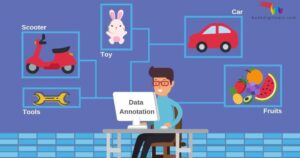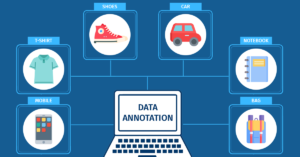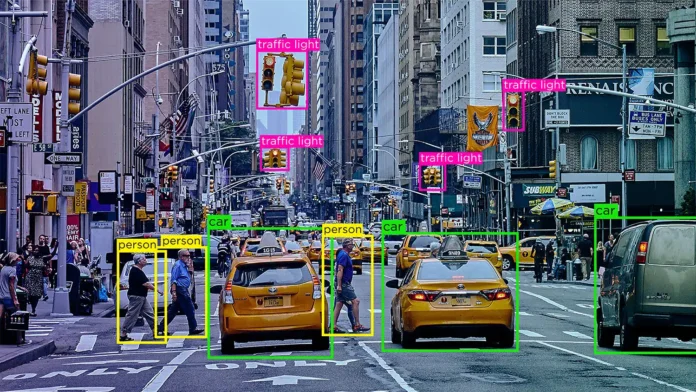Data annotation tech is transforming how we handle and understand information. By using data annotation tech, businesses and researchers can label and organize data more efficiently. This process helps computers learn from the data, making them smarter and more accurate.
In this blog post, we’ll explore how data annotation tech works and why it’s so important. Whether you’re new to the concept or looking to deepen your knowledge, we’ll break down the basics and show you how data annotation tech can benefit various fields.

1. What Is Data Annotation Tech?
Data annotation tech helps label and organize information so computers can understand it better. Imagine teaching a computer to recognize different animals in pictures. With data annotation tech, you can mark each animal in the photo so the computer learns which is which.
Data annotation tech works by adding helpful tags or labels to data. These tags tell the computer what’s in the data, making it easier for machines to learn and make decisions. For example, if you have a bunch of photos of cats and dogs, you would use data annotation tech to tag each photo with “cat” or “dog.”
In short, data annotation tech makes data smart by helping computers understand it. It’s like giving the computer a map to find its way through lots of information. This process is super important for making technology work better and smarter.
2. Why Data Annotation Tech Is Important
Data annotation tech is really important because it helps computers learn and make better decisions. Without proper labeling, computers wouldn’t know what to do with all the data they get. Think of it like teaching a child how to read. If you label the words clearly, the child can read and understand the text better.
Using data annotation tech improves the accuracy of machine learning models. For instance, in self-driving cars, data annotation tech helps label images of road signs and pedestrians. This way, the car can recognize these important things and drive safely.
Another reason data annotation tech is important is that it helps in creating better AI systems. By providing clear labels and tags, we make sure that AI can learn correctly and perform tasks more efficiently. This technology is essential for many modern applications, from virtual assistants to image recognition.
3. How Does Data Annotation Tech Work?
Data annotation tech works by adding labels to data so that machines can learn from it. First, you collect a lot of raw data, like photos or text. Then, you use data annotation tech to add labels that describe what’s in the data. For example, you might label images with “cat” or “dog.”
After labeling, the annotated data is used to train machine learning models. These models learn from the labeled examples to recognize patterns and make predictions. This process helps the computer get better at understanding and processing new data.
In essence, data annotation tech acts like a teacher for machines. It guides them on what to look for in the data, making sure they learn correctly and can perform their tasks effectively. This method helps in creating smart systems that can handle complex tasks.
4. Types of Data Annotation Tech
There are different types of data annotation tech, each designed for specific tasks. One common type is image annotation, where objects in images are labeled to help machines understand them. This can include drawing boxes around objects or tagging images with descriptive words.
Another type is text annotation, where important parts of text are highlighted or labeled. This helps in understanding the context and meaning of the text. For example, labeling different parts of speech in a sentence can help a machine understand grammar.
Data annotation tech also includes audio and video annotation. In audio, sounds or speech are labeled to help recognize different voices or sounds. In video, actions or events in the video are tagged to make it easier for machines to analyze the footage.
5. Benefits of Using Data Annotation Tech
Using data annotation tech has many benefits. First, it helps machines learn more accurately. By providing clear labels, data annotation tech ensures that computers understand the data correctly, leading to better performance in tasks like image recognition and natural language processing.
Another benefit is that it saves time and effort. Instead of manually sorting through data, data annotation tech automates the process, making it faster and more efficient. This helps businesses and researchers handle large amounts of data without getting overwhelmed.
Finally, data annotation tech improves the quality of AI and machine learning systems. With well-labeled data, these systems can make more reliable predictions and decisions. This is crucial for applications like healthcare, where accurate data can lead to better outcomes.
6. Challenges in Data Annotation Tech
Despite its benefits, data annotation tech faces some challenges. One major issue is the need for high-quality labels. If the labels are incorrect or inconsistent, it can lead to poor performance in machine learning models. Ensuring accuracy in labeling is essential for good results.
Another challenge is the time and cost involved in data annotation. Annotating large datasets can be time-consuming and expensive. This is especially true for complex data types like images and videos, where detailed labeling is required.
Additionally, there is the challenge of keeping up with rapidly evolving data. As new types of data and tasks emerge, data annotation tech needs to adapt to handle these changes effectively. Staying updated with the latest technology and methods is crucial for overcoming this challenge.
7. Data Annotation Tech in Machine Learning
Data annotation tech plays a key role in machine learning. It helps in training models by providing labeled examples that the models learn from. For instance, in a machine learning project for image recognition, data annotation tech labels images with names of objects, so the model learns to recognize them.
The accuracy of machine learning models depends heavily on the quality of the data. With well-annotated data, models can make better predictions and decisions. This is why data annotation tech is so important in developing effective machine learning systems.
Moreover, data annotation tech helps in improving the performance of machine learning algorithms. By providing clear and accurate labels, it ensures that the models can learn and generalize from the data effectively. This leads to more accurate and reliable outcomes in various applications.
8. How to Choose the Right Data Annotation Tech
Choosing the right data annotation tech involves considering several factors. First, think about the type of data you have. Different types of data, such as text, images, or videos, require different annotation tools. Make sure the tech you choose matches your data needs.
Another factor is the complexity of your annotation tasks. If you need detailed labels or have a large amount of data, look for annotation tech that offers advanced features and can handle complex tasks efficiently.
Additionally, consider the cost and ease of use. Some data annotation tech can be expensive, so make sure it fits your budget. Also, choose a tool that is user-friendly and easy to integrate with your existing systems. This will help you get the most out of your data annotation efforts.
9. Data Annotation Tech Tools and Software
There are many tools and software available for data annotation tech. Some popular tools include Labelbox, VGG Image Annotator, and Amazon SageMaker Ground Truth. These tools offer various features for labeling images, text, and other types of data.
Labelbox, for example, provides an easy-to-use interface for annotating images and videos. It also offers collaboration features, so teams can work together on data annotation projects. VGG Image Annotator is another tool that focuses on image annotation and is known for its simplicity.
Amazon SageMaker Ground Truth is a powerful tool that uses machine learning to assist in data labeling. It helps in improving the efficiency and accuracy of data annotation by providing suggestions and automating some parts of the process.
10. How Data Annotation Tech Improves AI Accuracy
Data annotation tech is crucial for improving AI accuracy. By providing labeled examples, it helps AI systems learn and understand data better. For instance, in speech recognition, annotated audio data helps AI models learn different accents and speech patterns, leading to more accurate voice recognition.
With high-quality annotations, AI systems can make better predictions and decisions. This is especially important in fields like healthcare, where accurate data can lead to better diagnoses and treatments. Data annotation tech ensures that AI systems have the right information to perform effectively.
Moreover, data annotation tech helps in fine-tuning AI models. By continuously updating and refining the annotations, you can improve the performance of AI systems over time. This leads to more reliable and accurate AI applications in various industries.

11. Examples of Data Annotation Tech in Action
Data annotation tech is used in many real-world applications. One example is in self-driving cars, where data annotation tech labels images of road signs, pedestrians, and other objects. This helps the car’s AI system recognize these elements and drive safely.
Another example is in healthcare, where it is used to label medical images for diagnosis. Annotated images help AI models detect conditions like tumors or fractures, improving the accuracy of medical diagnoses.
it is also used in virtual assistants like Siri and Alexa. By annotating speech data, these systems can understand and respond to voice commands more accurately, making them more useful for users.
12. The Future of Data Annotation Tech
The future of data annotation tech looks promising with advancements in technology. As AI and machine learning continue to evolve, it will play a key role in improving these systems. New methods and tools are being developed to make data annotation faster and more accurate.
In the future, we might see more automation in data annotation. For instance, machine learning algorithms could assist in labeling data, reducing the need for manual annotation. This would make the process more efficient and cost-effective.
Additionally, it will likely become more adaptable to different types of data. As new data formats and sources emerge, annotation tech will need to keep up with these changes. This will ensure that it continues to support the growing needs of AI and machine learning applications.
13. Data Annotation Tech for Beginners
If you’re new to it, it’s helpful to start with the basics. Data annotation involves labeling data to help machines understand it. For example, you might label images with names of objects or tag text with important information.
Begin by learning about different types of data and the tools available for annotation. Start with simple tasks and gradually move on to more complex ones. There are many resources and tutorials available online to help you get started with it.
14. How Data Annotation Tech Supports Research
Data annotation tech supports research by providing a way to label and organize data for analysis. Researchers often need to sort through large datasets, and ti helps by adding meaningful labels. This makes it easier to analyze data and draw conclusions.
In research fields like medical studies or social sciences, data annotation tech can be used to categorize data into different groups. For example, in a medical study, researchers can annotate images with different types of medical conditions to help in the analysis.
Moreover, it enables more precise research results. By providing accurate and detailed annotations, researchers can ensure that their data is well-organized and reliable, leading to better insights and discoveries.
15. Data Annotation Tech vs. Manual Annotation
Data annotation tech and manual annotation are two ways to label data, but they have different approaches. Manual annotation involves humans labeling data by hand, which can be time-consuming and prone to errors.
On the other hand, it uses software to automate the labeling process. This can speed up the process and reduce the chances of mistakes. For example, in image annotation, software can automatically draw bounding boxes around objects, making it faster than doing it by hand.
However, manual annotation might still be necessary for tasks that require complex or nuanced understanding. Combining it with manual checks can provide the best results, ensuring both efficiency and accuracy.
16. Tips for Effective Data Annotation Tech
To get the most out of it, follow these tips. First, ensure that you use clear and consistent labeling guidelines. This helps in maintaining accuracy and avoiding confusion during the annotation process.
Second, choose the right tool for your data needs. Different tools offer various features, so pick one that suits your specific requirements. For example, if you’re working with images, a tool with strong image annotation features will be beneficial.
Lastly, regularly review and update your annotations. Data and technology evolve, and keeping your annotations current ensures that they remain relevant and useful for your machine learning models.
17. Data Annotation Tech and Data Privacy
Data privacy is an important consideration when using it. Since data annotation often involves handling sensitive information, it’s crucial to ensure that data is protected and kept confidential.
When selecting it, choose tools that comply with privacy regulations and offer secure data handling. This includes features like encryption and access controls to protect your data from unauthorized access.
Additionally, make sure that the annotation process follows best practices for data privacy. This might involve anonymizing data or obtaining consent from data subjects to use their information for annotation purposes.
18. The Role of Data Annotation Tech in Automation
Data annotation tech plays a significant role in automation by providing the necessary data for training automated systems. Automated systems, such as those used in manufacturing or logistics, rely on annotated data to learn and perform tasks efficiently.
For example, in a warehouse, automated robots use annotated data to identify and sort products. The it labels images of items, helping robots understand what they are and how to handle them.
As automation continues to grow, it will be essential in developing and improving automated systems. By providing accurate and detailed data, it helps ensure that automation processes are effective and reliable.

Conclusion
Data annotation tech is like a super helper for computers and machines, making them smarter and more accurate. By labeling data clearly, we teach machines how to understand and use information better. This tech is crucial for things like self-driving cars, voice assistants, and even medical research.
In the future, it will keep getting better and faster. It helps us make cool new things and improve existing ones. Whether you’re a beginner or a tech pro, understanding it can open up a world of possibilities. So, dive in and explore how this amazing technology can make a difference!


